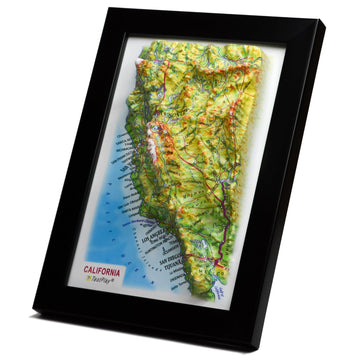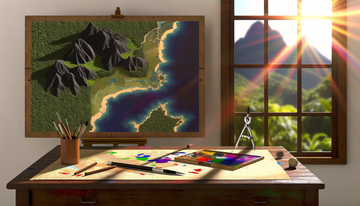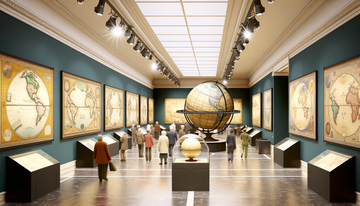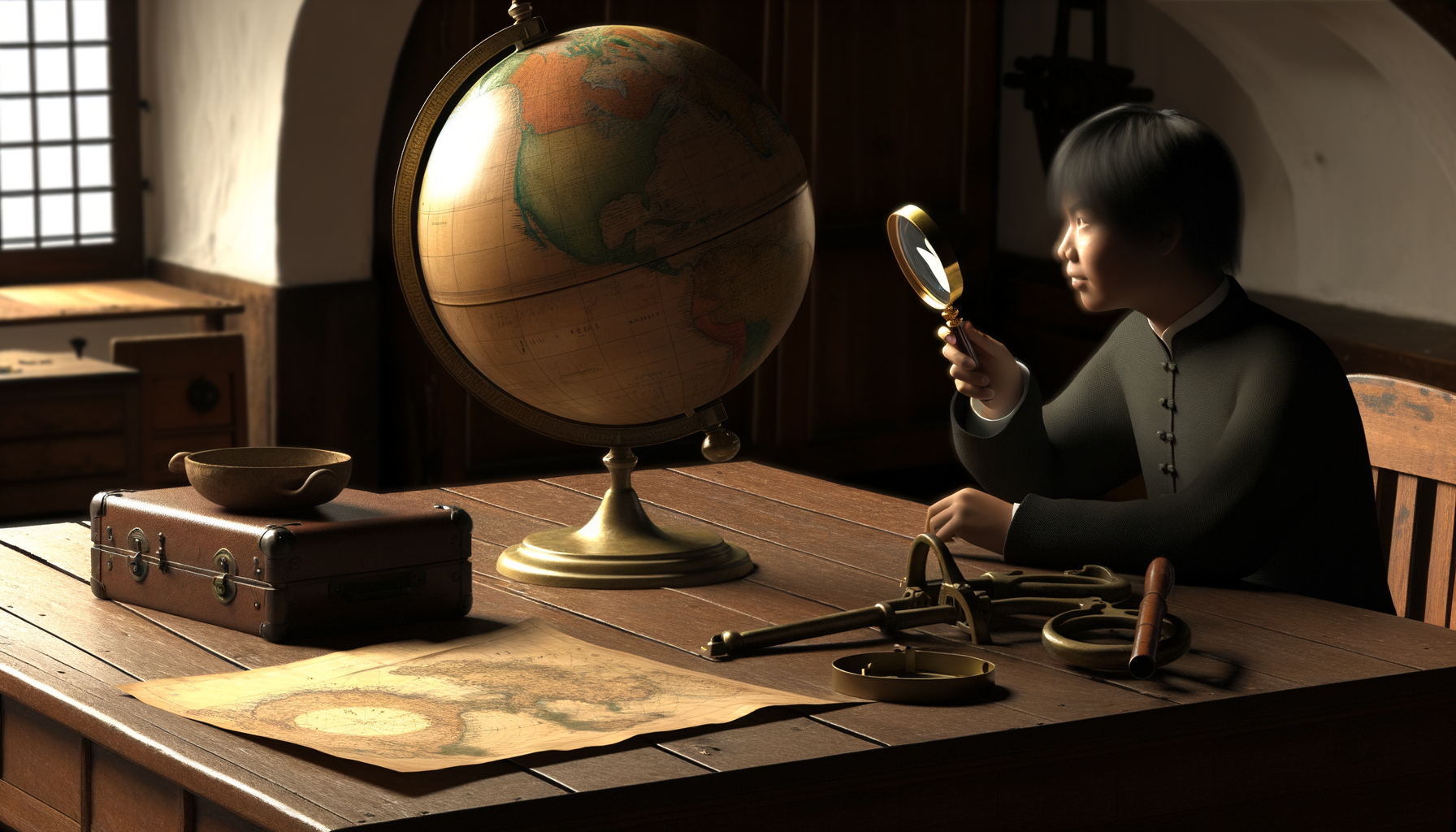Navigating with a Globe: More Than Just a Pretty Sphere
In an age dominated by digital maps and GPS, the traditional terrestrial globe often finds itself relegated to the status of a quaint decoration or a relic of a bygone era.
It sits silently on a shelf, a colourful sphere representing our world, yet rarely spun with intent.
However, this perception drastically underestimates the profound and enduring value of the globe as a tool for understanding our planet.
Far from being obsolete, the globe offers unique insights and educational benefits that digital interfaces simply cannot replicate.
This post delves into why the globe remains an essential instrument for geographic literacy, spatial reasoning, and gaining a true perspective on the Earth.
Beyond the Pedestal: The Enduring Value of the Terrestrial Globe
It is easy to look at a beautifully crafted globe and appreciate its aesthetic appeal, seeing it merely as a piece of decor that speaks of worldliness or a love for travel.
This common perception, however, risks obscuring its fundamental purpose and its power as an educational device.
The globe was, and still is, designed to be interactive, a miniature representation of the Earth intended for study and exploration.
Its spherical shape is not just for show; it is crucial for accurately depicting the relationships between places on a curved surface, something flat maps inherently struggle with.
Understanding the globe's true value requires shifting our perspective from seeing it as an object to viewing it as a dynamic tool for learning and discovery.
Why, in a world where virtually every corner of the planet is accessible via a few clicks, does a physical globe still matter?
The answer lies in the type of understanding it fosters.
Digital tools excel at providing specific information – directions from point A to point B, satellite imagery of a particular location, or detailed street views.
But they often present the world as a fragmented collection of places.
A globe, conversely, presents the world as a unified, interconnected whole, allowing for a holistic understanding of geography that is difficult to attain from a flat, two-dimensional representation.
It provides context, scale, and a tangible connection to the planet that digital screens cannot fully replicate.
A Journey Through Time: The Globe's Legacy
The concept of a spherical Earth has been understood for millennia, but the creation of accurate, detailed terrestrial globes is a testament to centuries of exploration, cartography, and scientific progress.
Early globes were often more artistic interpretations than precise maps, yet they represented a monumental step in visualizing the known world on its true shape.
From the Erdapfel created by Martin Behaim in 1492 (before Columbus returned) to the elaborate and scientifically advanced globes of the Dutch Masters like Blaeu, globes have served as vital tools for explorers, educators, and rulers.
They were symbols of knowledge and power, pushing the boundaries of geographic understanding.
While the technology behind their creation has evolved, the fundamental purpose – representing the Earth as a sphere for study – remains unchanged.
This rich history underscores the globe's proven utility as a geographical instrument, refined over centuries.
The Globe as an Essential Educational Instrument
Perhaps the most compelling argument for the globe's continued relevance lies in its unparalleled ability to teach fundamental geographic concepts in a clear and intuitive way.
Unlike flat maps, which must distort the Earth's surface to represent it on a plane, a globe maintains accuracy in terms of area, shape, distance, and direction simultaneously.
This spherical accuracy is crucial for developing a correct mental model of the Earth and the spatial relationships between different parts of the world.
It is a foundational tool for geographic literacy, essential for students and anyone seeking a deeper understanding of global dynamics.
Engaging with a physical globe provides a tactile learning experience that complements digital resources beautifully.
It allows users to physically interact with the world, spinning it, tracing paths, and observing relationships in three dimensions.
Building Foundational Geographic Literacy
Basic geographic concepts like continents, oceans, countries, and major cities come alive on a globe.
Their relative positions, sizes, and proximities are immediately apparent without the distortion introduced by flat projections.
A child learning geography can spin the globe and see how interconnected the continents are, how vast the oceans are, and where their own country sits in relation to the rest of the world.
This builds a robust mental framework for understanding global geography.
It is a more immersive and less abstract way to learn the basics compared to staring at a flat image.
The physical presence of the globe makes the reality of the Earth's shape and composition undeniable and easy to grasp for learners of all ages.
Furthermore, globes often display physical features such as mountain ranges, rivers, and deserts through colour and texture variations.
This adds another layer of understanding, showing how topography influences human settlement, climate, and global interactions.
Identifying the Andes, the Sahara, or the Amazon basin on a three-dimensional surface provides a different kind of insight than seeing them on a flat map, highlighting their scale and impact on the surrounding geography.
This visual and tactile engagement reinforces learning and helps solidify geographic knowledge in a memorable way.
The foundational knowledge gained from interacting with a globe serves as a critical base for more complex geographic studies.
Fostering Spatial Reasoning and Perspective
Spatial reasoning, the ability to think about objects in three dimensions and understand their relationships in space, is a critical cognitive skill.
The globe is an exceptional tool for developing this skill in a geographic context.
By its very nature, it requires the user to think in three dimensions about locations and pathways.
For example, understanding why a flight path from London to Tokyo appears curved on a flat map but looks like a relatively straight line (a great circle route) on a globe directly exercises spatial reasoning.
It challenges the intuitive but incorrect assumptions derived from two-dimensional representations.
This ability to visualize and manipulate spatial information is valuable not only for geography but also for fields like mathematics, science, engineering, and even everyday navigation.
A globe helps cultivate a global perspective.
Spinning the globe allows one to see how different regions face the sun or are plunged into darkness at the same moment, illustrating the concept of rotation.
It enables comparisons of size and distance between regions that might be misleading on certain map projections.
Seeing how close the Arctic regions of Russia and Canada are, despite appearing far apart on many flat maps, provides a powerful spatial insight.
This perspective is vital for understanding global connectivity, trade routes, climate patterns, and geopolitical relationships.
The tangible nature of the globe anchors this spatial thinking in a concrete reality, making it easier to internalize.
Grasping Scale, Distance, and Proportion
One of the most significant distortions on flat maps is the representation of area and proportion, particularly noticeable near the poles in the common Mercator projection.
Greenland, for instance, often appears larger than Africa on a Mercator map, when in reality Africa is approximately 14 times larger.
A globe accurately depicts the relative sizes of countries and continents.
This visual accuracy is vital for preventing misconceptions about the world and for understanding global demographics, resource distribution, and political influence.
Seeing the true scale of the continents and oceans is a fundamental part of geographic literacy that a globe conveys without distortion.
Furthermore, a globe is the best tool for understanding distance as measured along the Earth's surface.
The shortest distance between two points on a sphere is along a 'great circle' – a circle whose plane passes through the center of the Earth.
Globes allow you to visualize and even measure these great circle routes, explaining why trans-oceanic flights often follow curved paths at high latitudes.
While digital tools can calculate these distances, seeing them demonstrated on a physical sphere provides a deeper understanding of *why* the path is the way it is.
The accurate representation of scale and distance on a globe is fundamental to truly comprehending the physical dimensions of our planet and the relationships between its diverse regions.
This accurate perspective is invaluable for anyone studying travel, trade, or global logistics.
Visualizing Complex Geographic Phenomena
Beyond basic maps and scale, the globe is an excellent aid for understanding dynamic and abstract geographic concepts that are difficult to visualize on a static, flat image.
The Earth is a complex system, and its spherical shape plays a crucial role in many global phenomena.
A globe provides the necessary three-dimensional context to make these concepts more intuitive and less abstract.
Watching how the sun illuminates different parts of a spinning globe, for example, provides a clearer understanding of day and night than any diagram.
Similarly, concepts related to climate, oceanography, and atmospheric science are intrinsically linked to the Earth's spherical form and its movements in space.
Latitude, Longitude, and Global Positioning
Understanding how latitude and longitude form a grid system to pinpoint any location on Earth is foundational to modern navigation and geography.
On a globe, the lines of latitude (parallels) and longitude (meridians) are clearly depicted as they exist in reality – latitude lines as circles parallel to the equator, and longitude lines as great circles passing through the poles.
Seeing these lines wrap around a sphere makes their purpose and function immediately apparent.
It is easier to grasp why meridians converge at the poles on a globe, while on a flat map they appear parallel or converge unnaturally at the edges.
This visual clarity is essential for learning how coordinates work and for understanding global positioning systems.
The globe provides the perfect physical model for this crucial geographical concept.
Understanding Time Zones and the Earth's Rotation
Time zones are directly linked to the Earth's rotation and its longitudinal lines.
As the Earth spins on its axis, different longitudes face the sun at different times, creating the need for distinct time zones.
Using a globe, you can mark a point and visualize how it moves from darkness into light as you spin the sphere, passing through different longitudes.
This dynamic demonstration makes the concept of time zones, the International Date Line, and the relationship between longitude and time difference much more intuitive than abstract explanations or flat maps which often simplify or distort this relationship.
A globe allows you to perform a miniature simulation of the Earth's daily rotation and its impact on time across the world.
This concrete example aids significantly in understanding a complex global system.
Experiencing Seasons and Earth's Tilt
Why do we have seasons? This is a concept many people struggle to visualize.
It is not primarily about the Earth's distance from the sun (which varies only slightly) but about the tilt of the Earth's axis relative to its orbital plane.
A globe, mounted at the correct angle (usually 23.5 degrees), is the perfect tool to demonstrate this.
By tilting the globe and moving it around a light source representing the sun, you can visibly show how different hemispheres receive more direct sunlight at different times of the year.
This clear demonstration of the axial tilt and its effect on solar radiation is far more effective than diagrams in a textbook or on a screen.
It provides a tangible model for understanding one of the most fundamental global climate phenomena.
Seeing which parts of the globe are tilted towards or away from the "sun" immediately clarifies why hemispheres experience opposite seasons.
This makes the abstract concept of Earth's orbit and tilt concrete and easy to grasp.
Ocean Currents and Wind Patterns
While globes typically show the major ocean currents and prevailing winds, their spherical nature aids in understanding the forces that drive these global patterns, particularly the Coriolis effect.
This effect, caused by the Earth's rotation, influences the direction of currents and winds, causing them to curve.
While a globe does not dynamically demonstrate the Coriolis effect, seeing global current and wind patterns mapped onto a sphere provides a more accurate representation of their flow than a flat map where the curvature is lost.
It helps visualize how these systems interact across vast oceanic and atmospheric regions, connecting different parts of the world through climate and weather.
Understanding these global systems is crucial for climate science, navigation, and ecological studies, and the globe provides the essential context of the Earth's true shape.
The continuity of these patterns around a sphere is immediately evident, unlike on a map split at the edges.
The Globe as a Complement to Digital Navigation
It is not about replacing digital tools with a globe; it is about recognizing how the globe offers something different yet equally valuable.
Digital maps are superb for getting detailed directions, finding specific addresses, or exploring satellite imagery of a neighbourhood.
They offer granular detail and real-time information.
A globe, however, excels at providing the 'big picture' context.
It helps you understand where you are in the world on a fundamental level, the vastness of distances, and the relationships between large geographical regions.
Think of digital maps as street-level guides and the globe as the comprehensive world atlas that gives you perspective before you zoom in.
Using both tools provides a more complete and nuanced understanding of geography and navigation.
Big Picture Context vs. Turn-by-Turn Details
When planning a trip, a digital map can give you precise routes and estimated travel times.
A globe, however, shows you the overall journey, the continents crossed, the oceans traversed.
It helps you understand the geographic reasons behind routes – why flights go over the Arctic, or why certain trade routes developed over others.
This higher-level, contextual understanding is often lost when relying solely on turn-by-turn directions.
The globe provides the framework upon which digital details can be placed, making the information more meaningful.
It allows you to step back and appreciate the global context of any specific location or journey you might explore digitally.
This complementary use enhances both navigational skill and geographic knowledge significantly.
Analog Engagement in a Digital World
In an increasingly digital world, the physical interaction with a globe offers a different kind of engagement.
Spinning the globe, touching the continents, tracing a finger along lines of latitude or longitude provides a tactile and kinesthetic learning experience.
This analog interaction can be particularly beneficial for learners who respond well to physical engagement.
It offers a break from screen time and encourages direct, unmediated exploration of the Earth's surface.
This simple act of spinning a globe can spark curiosity and prompt questions in a way that passively viewing a screen might not.
It's a hands-on tool that invites active learning and personal discovery about the world.
The Inspirational and Aesthetic Dimensions
While the primary focus should be on its utility, it is impossible to ignore the inspirational and aesthetic qualities of a globe.
A well-crafted globe is a beautiful object, a piece of art that represents the entirety of our shared home.
Its presence in a room can serve as a constant reminder of the wider world, fostering a sense of connection and curiosity.
It is a visual prompt for learning, encouraging questions about faraway places, different cultures, and global issues.
This aesthetic appeal is not just about decoration; it is about inspiration.
It encourages contemplation about our place on the planet and the vastness and diversity of the Earth.
The globe serves as a silent invitation to explore and understand the world beyond our immediate surroundings.
A Tangible Connection to the World
In a world that can sometimes feel abstract and disconnected, a physical globe offers a tangible connection to the planet.
Holding the world in your hands, even in miniature, provides a sense of scale and reality that digital interfaces often lack.
It makes the Earth feel real and approachable, not just a collection of images and data points.
This physical connection can deepen appreciation for the planet's geography and foster a sense of environmental stewardship.
It reminds us that we are part of a single, interconnected global system.
The tangible object grounds our understanding in a way that purely digital representations cannot.
It is a constant, physical link to the global community and the natural world.
A Catalyst for Curiosity
A globe is a powerful catalyst for curiosity, particularly for children.
Its vibrant colours and detailed maps invite exploration.
Spinning it to see where your finger lands, finding famous landmarks, or tracing imaginary journeys sparks questions and encourages learning.
Why is that ocean so big? What is life like in that country on the other side of the world? Why are some areas green and others brown?
These simple interactions can lead to deeper investigations and a lifelong interest in geography, culture, and global affairs.
The globe serves as an accessible entry point to understanding complex global dynamics.
It is an object that encourages interaction, questions, and a desire to learn more about the planet we inhabit.
This innate ability to inspire curiosity makes the globe an invaluable tool in any learning environment.
Choosing and Using Your Globe Effectively
If you are convinced of the globe's value and considering acquiring one, there are a few things to keep in mind.
Globes come in various sizes, styles, and with different features.
Basic political globes show countries and borders, while physical globes emphasize topography and geographical features.
Illuminated globes can show political boundaries when lit and physical features when not, or vice versa.
Some globes are raised relief, allowing you to feel the mountains and valleys.
For educational purposes, a clear, detailed political or physical globe of a reasonable size (at least 10-12 inches in diameter) is recommended for ease of viewing and interaction.
Consider the accuracy and recency of the map data, although minor boundary changes do not negate the fundamental educational value related to scale, shape, and spatial relationships.
Durability is also a factor, especially if it will be used frequently by children.
There are also specialty globes showing stars (celestial globes) or the moon or other planets, each serving unique educational purposes.
Choosing the right globe depends on your primary use case, whether it is for general education, specific geographic study, or simply inspiration.
Once you have a globe, use it actively.
Do not just let it gather dust.
Here are some simple ways to utilize your globe effectively:
Spin it and stop it randomly. Identify where your finger lands and learn about that place.
Trace routes between cities or continents to visualize distances and great circle paths.
Use it with a light source to demonstrate day and night and the concept of time zones.
Use it with a tilted axis (most globes are mounted this way) and move it around a light source to demonstrate seasons.
Compare the sizes of countries and continents, particularly those that appear distorted on flat maps.
Identify major mountain ranges, rivers, and deserts and discuss their impact on surrounding areas.
Use it in conjunction with digital maps – find a location on the globe to understand its global context, then look it up digitally for details.
Make using the globe a regular activity, integrating it into learning or simply using it as a reference point during discussions about world events, travel, or nature.
Its presence can spark spontaneous moments of learning and discovery.
Engaging with the globe should be an interactive experience, encouraging questions and exploration of the world's geography.
Turning the sphere allows for a unique perspective on global interconnectedness and the physical realities of the planet.
Utilizing these simple techniques can transform a globe from a static object into a dynamic learning tool that provides endless opportunities for geographic discovery and understanding of our planet's physical form and political landscape.
Conclusion: Reclaiming the Globe's Significance
The terrestrial globe is far more than a decorative item; it is a powerful, enduring tool for geographic understanding, spatial reasoning, and fostering a tangible connection to our planet.
In a world increasingly reliant on digital interfaces that can sometimes flatten our perception of the Earth, the globe offers a vital three-dimensional perspective.
It accurately depicts the relationships between places, helps visualize complex global phenomena like seasons and time zones, and provides a fundamental understanding of scale, distance, and proportion that flat maps cannot match.
The tactile engagement it offers provides a unique learning experience that complements digital resources, providing essential context that turn-by-turn navigation often misses.
Beyond its educational utility, the globe serves as an inspiring reminder of the vastness and interconnectedness of the world, acting as a catalyst for curiosity and exploration.
Reclaiming the globe's significance means recognizing its unique strengths and integrating it back into homes, classrooms, and workplaces as a fundamental instrument for geographical literacy and global awareness.
It is not obsolete; it is essential, offering a timeless way to navigate and understand our dynamic planet.
Embracing the globe is embracing a foundational method for comprehending the physical reality of Earth and our place within it, providing an invaluable perspective that transcends the limitations of two-dimensional representations.
The pretty sphere is indeed a powerful tool, one that continues to be relevant and necessary for anyone seeking a true understanding of the world.
Its value lies not just in the information it holds, but in the way it allows us to interact with that information, shaping our spatial understanding and nurturing a global perspective.
As we move forward, let us ensure that the globe remains a central part of how we learn about and connect with the Earth.
It stands as a testament to centuries of geographic exploration and a powerful reminder of the unified, spherical nature of our home in the cosmos.
Incorporating a globe into learning or living spaces provides a constant opportunity for discovery and reinforces a crucial, accurate mental model of the world.
The pretty sphere is an indispensable tool for navigating with a true sense of the planet's geography and interconnectedness.




